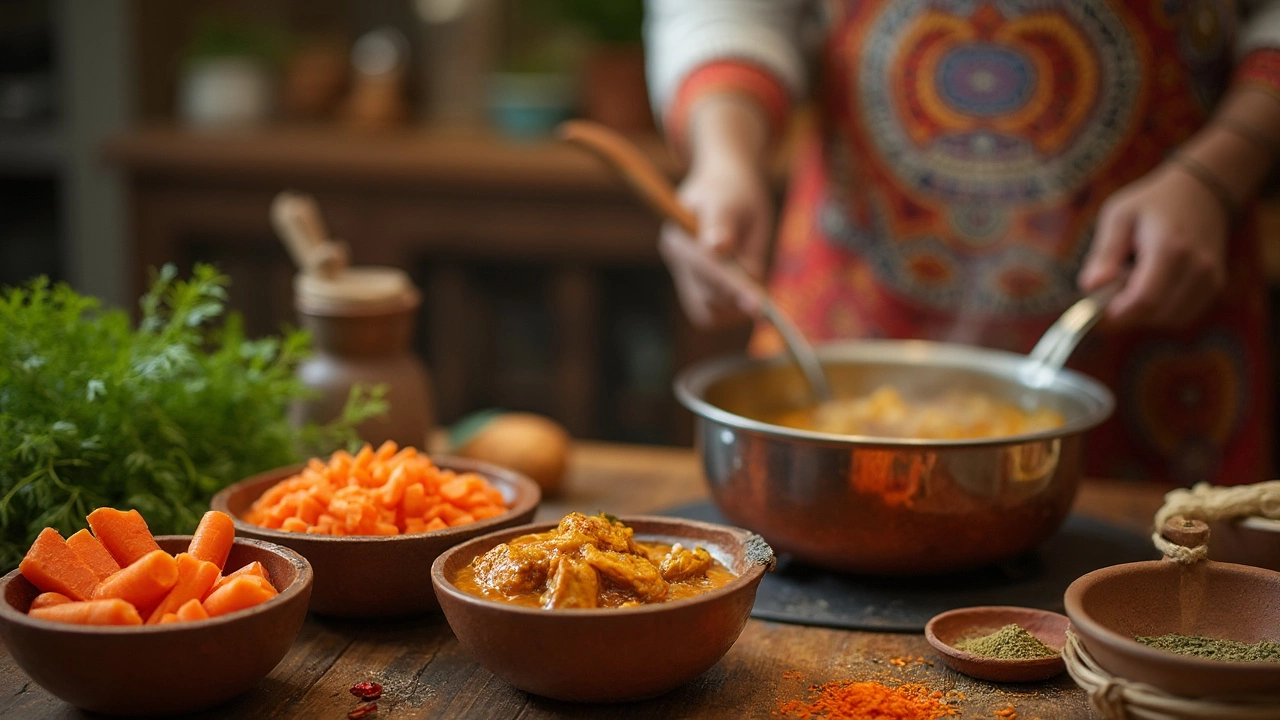Carrot Preparation: Tips, Techniques, and Indian Flavors
When working with carrot preparation, the process of getting carrots ready for cooking or eating. Also known as carrot prep, it covers everything from peeling to seasoning. A fresh carrot, a root vegetable packed with beta‑carotene, fiber, and a sweet crunch works best when you pair it with the right spices, such as cumin, coriander, and mustard seeds, which bring out its natural sweetness and the broader context of Indian cuisine, a diverse food culture that often celebrates vegetables in vibrant ways. Below you’ll find practical ways to master each step and why it matters for flavor and nutrition.
Core Techniques Every Home Cook Should Know
First up, the basic cuts. Peeling a carrot removes the thin, sometimes bitter skin, while a quick slice lengthwise gives you matchsticks for stir‑fries. Grating creates fine shreds perfect for salads or the classic gajar ka halwa. If you prefer a softer bite, a quick blanch in boiling water for 2–3 minutes retains color and nutrients. Each method changes texture, which in turn influences how spices cling to the surface—a key link between technique and flavor.
Next, cooking methods. Roasting carrots at 200°C with a drizzle of oil brings out caramelized sweetness and concentrates their natural sugars. Sautéing in a hot pan with a pinch of mustard seeds adds a nutty pop that’s heard often in South Indian dishes. Steaming keeps carrots bright and crisp, ideal for a light side dish that pairs with dal or rice. Knowing which method fits your dish helps you balance taste, texture, and health benefits.
Tools matter too. A sharp chef’s knife ensures clean cuts, a sturdy grater speeds up shredding, and a micro‑plane works wonders for making carrot ribbons for garnish. Investing a minute in a good peeler can save you from uneven strips that cook unevenly. The right equipment reduces prep time and improves the final result, making carrot preparation less of a chore and more of a creative moment.
Spice pairing is where carrot preparation truly shines. Warm spices like cumin and coriander seed accentuate earthy notes, while sweet spices like cinnamon and cardamom turn carrots into dessert‑worthy treats. Fresh herbs—cilantro, mint, or fenugreek leaves—add brightness after cooking. When you understand how each spice interacts with carrot’s natural sugars, you can customize dishes for any meal, from a hearty lunch to a festive dinner.
Nutrition stays front‑center. Carrots bring beta‑carotene, which the body turns into vitamin A, supporting eye health. Cooking can boost bioavailability of some nutrients, but over‑cooking destroys vitamin C. A quick sauté or light steam keeps most nutrients intact while making the carrot easier to digest. Pairing carrots with a little healthy fat, like a splash of ghee or olive oil, further enhances nutrient absorption—a simple science fact that makes your meals healthier.
Let’s talk Indian dishes that showcase carrot preparation. In the north, gajar ka halwa uses grated carrots cooked slowly with milk, sugar, and cardamom for a sweet finish. In the south, carrot poriyal mixes small cubes with mustard seeds, urad dal, and curry leaves for a crunchy side. West Indian carrot soups blend carrots with coconut milk and turmeric for a soothing bowl. Each recipe highlights a different prep style—grating, cubing, or pureeing—showing how versatile carrots can be across regions.
If you’re new to Indian flavors, start with a simple carrot stir‑fry: heat oil, add cumin and mustard seeds, toss in diced carrots, sprinkle a pinch of turmeric, and finish with fresh cilantro. That quick dish teaches you how spice timing works—tempering seeds first releases aroma, then the carrots absorb the flavors. You can scale this up to larger meals or add peas, potatoes, or lentils for variety.
Seasonal considerations also affect carrot preparation. Fresh, young carrots are sweeter and softer, needing less cooking time. Older, larger carrots have a deeper flavor but can be tougher, benefiting from longer roasting or slow simmering. Choosing the right carrot based on your recipe ensures optimal texture and taste without extra guesswork.
Storage tips help you keep carrots ready for prep. Keep them in the fridge’s crisper drawer wrapped in a damp paper towel to retain crunch. If you’ve already peeled or cut them, submerge the pieces in cold water and change daily—it prevents browning and keeps them crisp for up to two days. This prep‑ahead approach saves time on busy weeknights.
Finally, experiment with fusion. Add grated carrots to a pancake batter for extra moisture, mix carrot puree into a BBQ sauce for sweetness, or blend carrots into a smoothie with ginger for a health boost. The possibilities are endless once you master the basic prep steps.
All these ideas—techniques, tools, spice pairings, nutrition, and regional dishes—form a solid foundation for your carrot preparation journey. Below you’ll find a curated collection of articles that dive deeper into specific carrot recipes, nutrition facts, and cooking hacks. Explore them to turn simple carrots into standout dishes for any occasion.

Boiling Carrots for Chicken Curry: Good or Not?
Wondering if you should boil carrots before adding them to your chicken curry? This practical article explores whether pre-boiling carrots enhances texture and flavor in curry dishes. We'll discuss how carrot preparation can affect cooking time, nutrient retention, and the overall taste. Get tips on when to use raw carrots for a crunchy texture and when boiling might be a better option. Master the art of integrating carrots into your favorite curry.